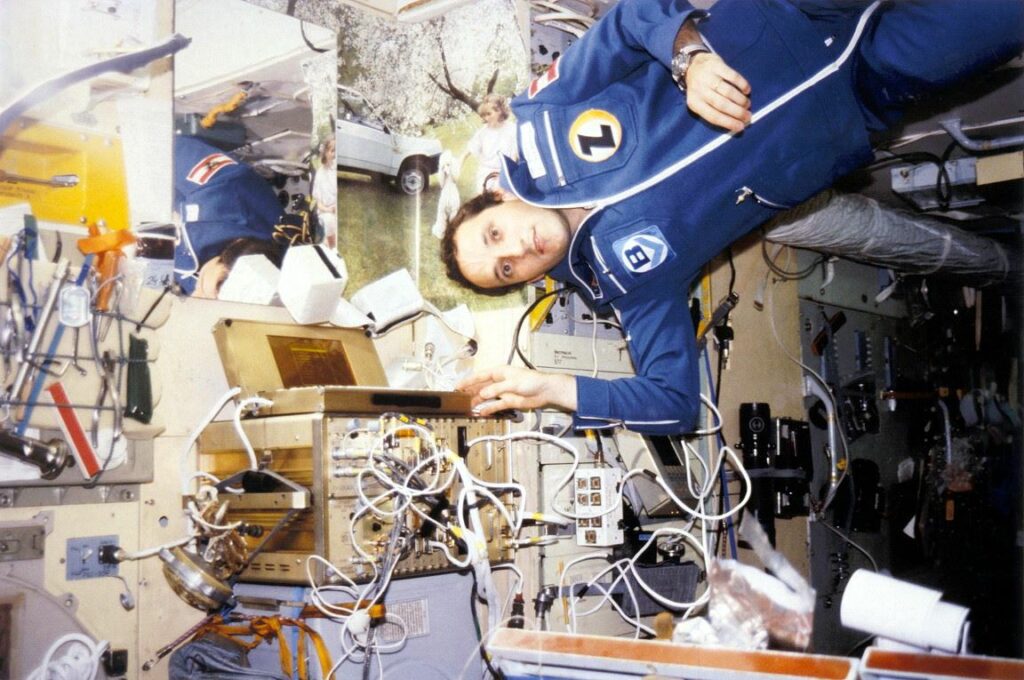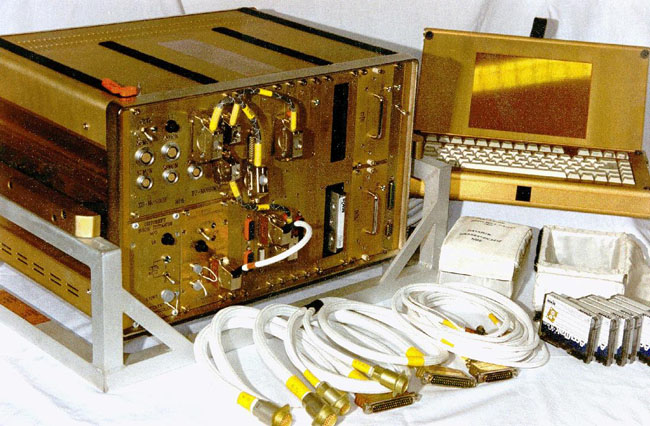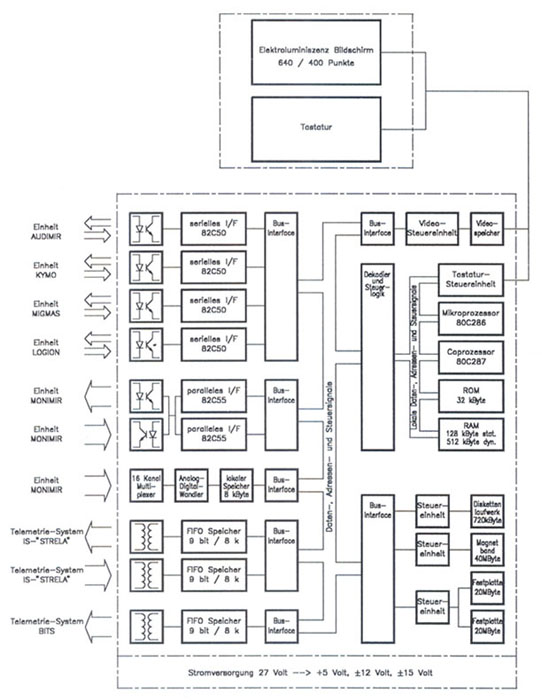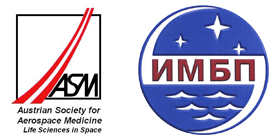DATAMIR is a computer system for the acquisition and recording of the medical und physical experiment`s data during the project RLF and was developed for the AUSTROMIR-91 project. The experimenters data were saved on board and twice per day saved on magnetic tapes. The magnetic tapes were brought back to earth with the cosmonauts after every phase.
The industry unit of the typ IBM/AT had to be adapted into a board computer for the space station MIR, to affect the bulk of the RLF-experiments, to record all experiment data, and supply the cosmonauts with the necessary briefings, outlines and checklists for the preparation of the experiments. The board computer already transferred experiment data during the mission over two available telemetry systems from the space station to the earth station.
Requirements
The DATAMIR system was already two years onboard the MIR space station at the beginning of the RLF mission. This system was originally only planned for the deployment in the AUSTROMIR project, a period of about 10 days. Considering all activities, the transport to the station, the deployment during the mission and the continuation of AUSTROMIR, the planned maximum operating time of 300 hours was already exceeded. In order to guarantee operation during the RLF mission, an additional set of reserve plates were contracted. A unit was manufactured for each plate. Two reserve plates were manufactured for the hard-disk module and the serial interface because two units were deployed in the DATAMIR system. Therewith a complete set of reserve parts was available. The reserve plates were tested for their functionality by the manufacturer. Furthermore, the plates were tested for compatibility with the laboratory model and the reserve flight model.
The DATAMIR software was consequently customized and enhanced for the new requirements of the experiments. In order to enable an efficient training of the team, a pre-version was created already taking into consideration the basic changes.
Because not all experiments of the AUSTROMIR project where carried out within the RLF framework, the menu structure had to be corrected. The entry for the AUDIMIR experiment was completely removed. The original acoustic stimulation for the first three part experiments of MONIMIR was replaced with an optical stimulation. Because of this, all the dialog text had to be revised because references to the AUDIMIR experiment existing in the dialogues of MONIMIR as well as of OPTOVERT.
The structure of the sub-menus for the OPTOVERT experiment was customized to the new experiment concept. A few part experiments and the calibration were cancelled or replaced by new ones. The dialog text was also customized according to the new experiment activities.
The order of the MONIMIR, MYO-MOTOSCAN (MOTOMIR), OPTOVERT and KYMO experiments was changed in multiple steps for the single phases of the RLF project. For this purpose, the experiments’ dialog text also had to be revised for the new conditions. The text was coordinated with the corresponding experimenters and finally incorporated with the corresponding text files.
A special transfer program was created for the transfer of the Russian text on DATAMIR in the data format for the Cyrillic font. In order to display the Cyrillic and Latin characters simultaneously, the Cyrillic characters in the range of 128 to 255 must be coded as a replacement for ASCII special characters. The most text programs methods were similar, but the assignment is different from program to program or even freely configurable. Additionally, a part of the ASCII special characters for the display of a frame were required on DATAMIR, so that a special coding must be established. For these reasons, the Russian text had to be newly coded for the deployment on DATAMIR.
Application for controling and data recording at the realization of the Austrian experiments:
COGIMIR, MIKROVIB, MONIMIR, MOTOMIR (MYO-MOTOSCAN), OPTOVERT, PULSTRANS & NIGHT
Results
All experiments supported by DATAMIR could be carried out completely as planned. The data was saved on 43 streamer cassettes and brought back to Earth.

In the course of program changes for MONIMIR, the LED information was removed from the data record by mistake. This error went unnoticed during the hand over tests because the display on the monitor was not affected by this and the measurement data was not evaluated in detail. This software version was therefore delivered on board with mistakes. In order to correctly evaluate the measurement data just the same, a program was created whose task was to integrate again the missing information in the data structure. Because the selection of the LED profile only occurred “nearly” randomly, the LED information could be uniquely reconstructed. The time at the beginning of the measurement was used as reference as this was stored in the file header.
Technical characteristics
The system consisted of the following units
Central unit
The central unit based on an industrial computer of the typ IBM/AT and had the following technical main characteristics:
- Microprocessor: 80C286
- Clock frequency: 10 MHz
- RAM: 640 kByte
- ROM: 32 kByte
- Floppy-disk: 720 kByte
- Streamer: 40 MByte
- Digital interfaces:
serial 4 channels
parallel 1 x 16 Bit
Interface to the board telemetry system BITS
Interface to the board telemetry system STRELA - Analog inputs: 16 channels, +10 V
- Overload protection: fuse 6.3 A
- Controls:
Power switch
Dispatcher for the hard-disks - Indicators:
Power control display
Operation display for the Floppy-disk
Operation display for the hard-disk (2 pieces)
Operation display for the streamer
Check display for the processor supply (+ 5 V)
For the transport to the space station MIR the central unit was provided with a vibration depressant transport frame. In the central unit DATAMIR the electronic box MONIMIR and the supply block OPTOVERT were built in.
| Mass: | (Transport configuration) (Operation configuration) |
max. 24.0 kg max. 22.0 kg |
| Dimensions: | (Transport configuration) (Operation configuration) |
552 mm x 320 mm x 432 mm 470 mm x 280 mm x 362 mm |


Aluminium container with following system components:
- Operating unit consisting of a monitor (monochrome, 640 x 350 pixel) and a keyboard (German – Russian)
- Cable loom (4 cables)
- Disk set in a cloth bag (6 disks)
- Streamer cassette sets in a cloth bag (2 sets with ever 6 cassettes)
- Reserve fuses
| Mass: | max. 10.0 kg |
| Dimensions: | 470 mm x 120 mm x 350 mm |
Hard-disk modules
Two hard-disk modules (each 20 MByte) were transported to the MIR packed in depressant foam plastic packages with cloth bags and first there built into the central unit.
| Mass: | max. 1.5 kg |
| Dimensions: | 140 mm x 200 mm x 330 mm |
The total power use of DATAMIR amounted max. 80W.
To increment the redundancy a set DATAMIR – spare parts consisting of the following components was accommodated into the scope of delivery:
- Video card
- Analog / digital transformer card
- Serial interface card
- Parallel interface card
- Main board
- Streamer / floppy-disk – unit
- Fuses 6.3 A (10 pieces)
These backup plates were individually packed into antistatic foil bags and into a cloth bag.
| Mass: | max. 4.9 kg |
| Dimensions: | 320 mm x 320 mm x 200 mm |
To the spare part set an aditional hard-disk module with transport packaging was added.
| Mass: | max. 1.5 kg |
| Dimensions: | 140 mm x 200 mm x 330 mm |
The transport of the spare parts to the MIR occured simultaneous with the equipment DATAMIR in the cargo transporter Progress M-9. For the project RLF further spare parts, streamer cassettes and a new software were brought to the space station MIR with Soyuz TM-18, Soyuz TM-19 and Soyuz TM-20.
Back load
- 20 streamer cassettes in foam plastic depressant cloth bags (Soyuz TM-18)
- 13 streamer cassettes in foam plastic depressant cloth bags (Soyuz TM-19)
- 10 streamer cassettes in foam plastic depressant cloth bags (Soyuz TM-20)
| Mass: | max. 750 g |
| Dimensions: | 117 mm x 107 mm x 87 mm |
Experimenters
Univ.-Prof. Dipl.-Ing. DDr. Willibald Riedler (institute manager)
Dr. Manfred Steller (project manager)
Dipl.-Ing. Paul Willière
Dipl.-Ing. Christian Wagner
all: Institute for Applied System Technology, Research Association Joanneum Ges.m.b.H, Graz
Dipl.-Ing. Joerg Schneider
all: Company NOVA AEROSPACE
V. Kosharinov
all: IMBP (Institute for Biomedical Problems), Moscow
